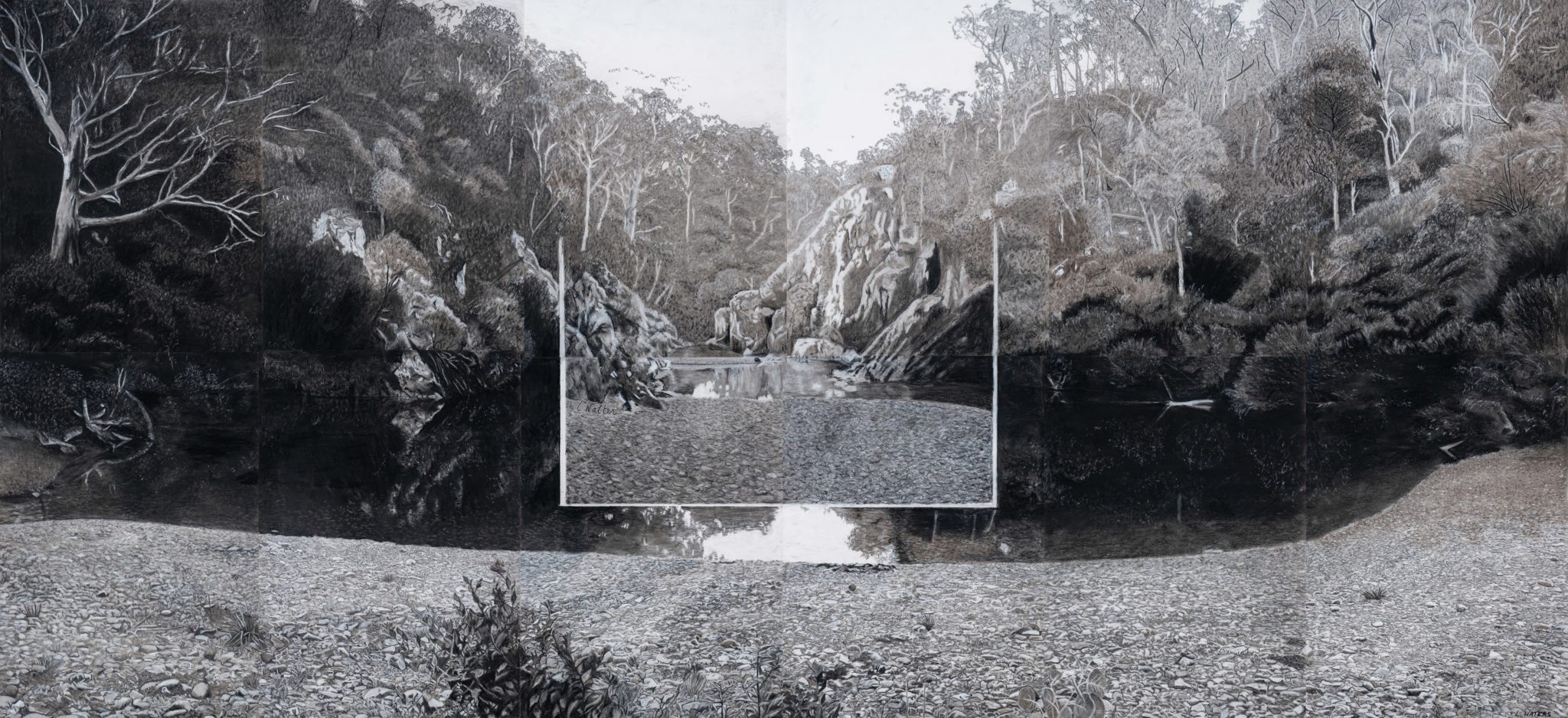Louisa WATERS
1. Untitled, 2021, Charcoal and graphite on paper, 116 x 245 cm, Commissioned by Latrobe Regional Gallery for 50 Years 50 Artists exhibition.
Louisa WATERS
Briagalong artist Louisa Waters is interested in examining the transformation of Gippsland (Gunaikurnai) since colonisation.
In 1892 the Crown Lands Bailiff charged William Mann in the Morwell Court for illegally building a dwelling on the banks of the Latrobe River near the Great Morwell Mine. The 1884 Land Act reserved two chains of all river frontage as Crown Land and prohibited it thus for private occupation. As a result, Mann was fined and ordered to leave his cottage.
With such an act in place settlers built towns, and communities away from the water and literally turned their backs on the essential source. Since colonisation, the waterways of Gippsland have been drastically redefined. Agricultural and mining sectors have utilised the resource from both the surface and aquifers, which are a conduit to waters tens of thousands of years old. Such activity has increased salinity and decreased the hydrology of the land. With their backs turned away from the water, water consciousness was limited.
Louisa Waters came upon a photograph taken by Carl (Charles) Walter. Walter was a nineteenth-century botanist and photographer who was part of a geodetic survey team that came to the Gippsland region from 1869 to 1871. The insert, middle section of Waters’ drawing is sourced from a photograph of the Blue Pools, a waterhole just north of Briagolong taken by Walter during this expedition.
Photography played a role in imaging the colonies – but it was also an unsuspecting witness to narratives which can be reflected upon differently in the contemporary context. In this case, Walter captured a particular moment of the Freestone Creek. Towns were erected on the Gladstone and Lee’s creek during the fleeting gold rush.
The Freestone Creek and many of the tributaries that flowed into it were heavily mined for gold, and much of the water was being sluiced out. As a result, the waterhole depicted at this time is lacking in water.
Many early colonisers who perhaps did not deem themselves ‘artists’ would sketch scenes from their expeditions. Often revealing, colonial sketchbooks didn’t always portray the ideal or the grand vista. Instead, the impenetrable forests featured as did the minutiae. Drawing not only leaves a trace of time and of the objects drawn, but as William Kentridge suggests, “the activity also leaves a trace of yourself – the artist and the movements of your hand and the time you have spent with it.” 1
The substantive area of Waters’ drawing is derived from a photograph the artist took in recent years of the same scene. The artist is seeking to imply the present and past are intertwined. Photos capture a ‘still’, a small slice from a continuum of time. The artist uses these notions of time, the time of drawing and marks (the archaeological time of char-coal), photographic stills and the medium of video that speaks to time and duration. In the video that forms a vital part of the work, archival photographs of Gippsland waterways during the nineteenth century are used. The footage of the flooding waters came from the recent 2021 floods. The footage is taken from the Delta Bridge on Freestone Creek. After years of agriculture and mining draining the creek from either its surface or aquifers below, this part of the creek seldom flows, only for flooding events like these.
The Rorschach imagery is composed of archival images of Gippsland waterways during the nineteenth century. The Rorschach resonates with the reflections of the water, where the land meets with the water and reflects back. This creates a link between our current ecological crisis and leading us to reflect back upon our past.
1. Leora Maltz-Leca, William Kentridge: Process as metaphor and other doubtful entreprises, Oakland: University of California Press, 2018
